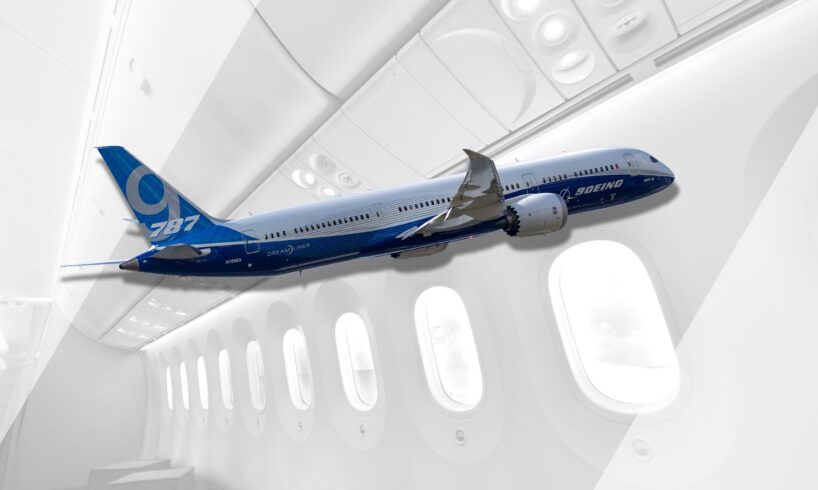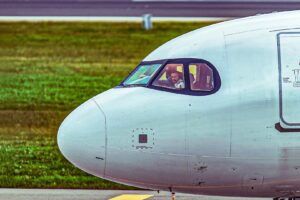
The Boeing 787 and Airbus A350 are very competitive long-range, widebody aircraft; both have higher cabin pressure, are clean-sheet designs, and feature extensive use of composite materials. Many passengers may prefer one over the other for various reasons, or they may consider the aircraft to be substantially the same. But where almost everyone can agree is that the Boeing 787 Dreamliner’s windows are in another class.
The Dreamliner’s large windows offer comparatively fantastic views, while the automatic dimming seems much more appropriate for a modern aircraft than cheap-feeling plastic shutters. The use of a gel layer between panes that changes opacity when an electrical current is applied allows passengers to adjust the window’s transparency. Here is what to know about the Dreamliner’s large windows.
The Boeing 787’s Large Windows
Photo: eric1207cvb l Shutterstock
The Boeing 787 Dreamliner boasts the largest cabin windows of any of today’s commercial aircraft. They are 70% larger than those on comparable aircraft. Boeing is able to accomplish this thanks to the way the fuselage is constructed. The Dreamliner’s fuselage is made of one-piece composite barrel sections instead of the traditional aluminum sheets and many fasteners that previous aircraft, like the Boeing 767, are made of.
These lightweight composite single-piece sections come with numerous benefits. Not only does it make the aircraft light and help save on fuel, but it also allows the aircraft to be pressurized more. But there’s another benefit. Windows are essentially holes in the fuselage and are weak spots from an engineering perspective. Windows in aluminum fuselages are limited in size so as not to compromise the integrity of the aircraft.
However, as the Boeing 787’s fuselage segments are single-piece, the fuselage is more resistant to fatigue. Boeing engineers were able to fit larger windows into it without compromising its integrity. Yet another benefit for passengers is that Dreamliners have increased cabin humidity, which also increases passenger comfort.
Automatic Dimming Windows
Photo: Martin Chavez l Shutterstock
The company behind the window’s automatic dimming is Gentex. Gentex is a leader in electrochromic (auto-dimming) technology, and its headquarters are based in Zeeland, Michigan. The company states, “We are the leading supplier of electronically dimmable windows (EDWs) for the aerospace industry, having launched the first major EDW program with the introduction of the Boeing 787 Dreamliner.”
The ability to dim windows allows passengers to control the amount of visible light entering the cabin. It means passengers can cut out the glare while still enjoying the view as the aircraft flies. This is in contrast to the binary function of mechanical or electromechanical systems. Passengers can control the windows individually, or groups can be controlled by the flight crew simultaneously.
An override allows the crew to tune the cabin to the desired in-flight environment for daytime and overnight segments of the flight. They also come with wireless control integration that allows for a clean aesthetic and simple design, eliminating the need for packaging space to accommodate a switch and wired communication lines. They are an elegant replacement for conventional pull-down shades.
Related
Why The Boeing 787-9 Dreamliner Has Much Longer Range Than The 787-10
The higher-capacity jet has some impressive capabilities.
The Boeing 787’s Many Innovations
Photo: BoeingMan777 | Shutterstock
The Boeing 787’s structure by weight is around 50% composite materials and an impressive 80% composite by volume. Composite materials are found in the fuselage, wings, tail, doors, and interior. As previously stated, increased cabin pressure provides more comfort to passengers. Being pressurized to around 6,000 feet above sea level, passengers experience less bloating and fatigue. Most aircraft are pressurized to 8,000 feet, although other new aircraft like the A350 are also pressurized to 6,000 feet.
Unlike its Boeing 767 predecessor, the Dreamliner is also able to service some of the longest routes in the world. The 787-9 has a range of 7,305 nautical miles, the stretched 787-9 has a range of 7,565 nautical miles, while the further-stretched 787-10 has a reduced range of 6,330 nautical miles. Among other things, this enabled it to compete with aircraft like the Airbus A380 on long and ultra-long haul routes.
Boeing 787 Dreamliner:
Entered service:
2011
Number delivered:
1,188
Number on order:
948
Passengers carried:
248-339 depending on variant in a typical two-class layout
Range:
6,330-7,565 nautical miles, depending on variant
As with other modern aircraft, the Boeing 787 Dreamliner is also designed to be much quieter than its older aircraft predecessors. It is designed to have a noise footprint (the noise on the ground affected by the aircraft) up to 60% lower than that of its predecessor aircraft. Meanwhile, the cabin is also quieter for the passengers flying. When the Dreamliner entered service in 2011, it represented the pinnacle of commercial aviation engineering.
The Boeing 777X’s Bigger Windows
Photo: Falcons Spotters | Shutterstock
The Boeing 787 Dreamliner’s windows are soon to be joined in the skies by the updated Boeing 777, the 777X. The Boeing 777X features 162 square-inch windows, which also have a higher placement than the previous generation windows. These windows are 29% larger than the Airbus A350’s windows. For comparison, the existing Boeing 777 windows are already 160 square inches and are 12% larger than the A350’s 125 square inch windows.
Currently, the Boeing 787 has the largest windows in the sky, measuring 10.7 inches by 18.4 inches. Until the Boeing 777X enters service, the Boeing 777 has the second-largest widebody windows in the sky, although oddly enough, they are smaller than the narrowbody A220. The Boeing 777 comes with windows measuring 10 inches by 15 inches, which are the same windows as those found on the Boeing 767-400ER and the main deck of the Boeing 747-8.
Select aircraft types:
Window dimensions:
Boeing 787 Dreamliner:
10.7 x 18.4 inches
Boeing 777-300ER:
10 x 15 inches
Boeing 767-400ER:
10 x 15 inches
Airbus A220:
11 x 16 inches
Airbus A350:
9.5 x 13.5 inches
Airbus A330:
9 x 12.3 inches
As a rule of thumb, Airbus has comparatively smaller windows with the exception of the Airbus A220 (originally the Bombardier CSeries). The Airbus A220 comes with extra-large windows for a narrowbody aircraft measuring 11 inches by 16 inches. While the A350’s windows are small compared with the Dreamliner, it is still larger than other Airbus aircraft. The A350’s windows measure 9.5 inches by 13.5 inches. Meanwhile, the A330 and A340 both have windows measuring 9 inches by 12.3 inches.
Related
Comparing Cabins On The World’s Longest Boeing 787 Dreamliner Routes
How does the experience differ when flying long-haul with Qantas, Air New Zealand and United Airlines?
Sightseeing Over Antarctica
Photo: Austin Deppe l Shutterstock
Qantas operates a fleet of 14 Boeing 787-9s. Qantas is unique for being the only airline to fly to all seven continents (or eight continents if Zealandia is accepted as a continent). Qantas operates seasonal sightseeing flights over Antarctica, although these flights don’t actually land in Antarctica. Every year, Qantas charters special flights across the world’s frozen continent using its Boeing 787-9s. This is one time passengers can really enjoy the large windows of the Dreamliner.
Qantas has been flying sightseeing flights over Antarctica since 1994. The current flights have up to four hours of flight time over the continent before returning to the same airport from which they took off in Australia. The flights depart from Melbourne, Sydney, Brisbane, and Perth and during the 2025-2026 season, Qantas is chartering a total of seven flights. This is a rare case where the large windows of the Dreamliner are actually used for tourism and take center stage for the flight.
Qantas notes that the windows on the 787s are some of the largest in the sky. The cost of the flights depends on the seat selection, with some seats offering better views than others due to obstruction by the wings. Pricing also varies based on class. As these are the same aircraft Qantas uses for international flights, the aircraft have economy, premium economy, and business class seats. Price ranges from USD 775 to USD 5,040.
A Clear Advantage Over Airbus
Photo: Real_life_photo | Shutterstock
Boeing is set to build on the success of its Dreamliner windows with its new Boeing 777X. Not only will these windows be large, but they will come with improved dimming. The Boeing 777X will be the first to use Gentex’s latest EDW technology. This is capable of eliminating more than 99.999% of the visible light at twice the darkening speed of previous windows.
Some of the Boeing 787’s advances, like its composite structure and increased efficiency, are of little interest to many passengers. Meanwhile, other advances that improve the in-flight experience for passengers, like increased cabin pressure and increased humidity, often go unnoticed. However, most passengers can’t help but notice the aircraft’s large and automatically dimming windows. These are windows with no commercial analog until the Boeing 777X enters service.
Boeing and Airbus are in intense competition with each other, with each offering advantages or disadvantages over the other. Over time, Airbus has eaten into more and more of Boeing’s market share and is now the largest commercial aircraft maker. However, at least when it comes to windows in widebody aircraft, it seems Boeing has a distinct advantage, and it is unclear when Airbus will close the gap. It’s also possible that the future of flying will have less outside viewing. This is particularly true if blended-wing-body aircraft, like JetZero’s Z4, prove successful. But for now, passengers can enjoy the excellent views from the Dreamliner.






